Being a responsible car owner goes hand in hand with proactive maintenance. However, understanding the intricate mechanical parts of cars can feel overwhelming. To make informed decisions when repairs are needed, it’s crucial to familiarize yourself with the key components that keep your vehicle running smoothly and safely.
It’s essential to know which car parts can pose a safety risk if they malfunction and which are relatively inexpensive to maintain. This guide will explore the inner workings of a car, from the engine’s pistons to the wheels’ tires, providing a comprehensive overview of All Parts Of A Car and their functions.
Understanding all parts of a car is key to proper maintenance and cost management.
Let’s delve into the various systems and components that make up a car, ensuring you have a solid understanding of your vehicle’s anatomy.
Engine Components
Maintaining your engine, composed of numerous parts of a car, ensures vehicle longevity and reduces running costs.
The engine is the heart of any car, converting fuel into motion. It’s comprised of several crucial parts working in harmony.
Cylinder Block and Pistons
The cylinder block serves as the engine’s structural foundation, a robust housing containing the cylinders. These cylinders are hollow chambers where combustion takes place.
Within these cylinders, pistons move up and down, driven by the force of combustion. Piston rings ensure a tight seal, maximizing efficiency. This piston movement is the primary mechanism for converting the energy from fuel combustion into mechanical power, which ultimately propels the vehicle – a fundamental process among all parts of a car that contribute to motion.
Crankshaft and Camshaft
Deep within the engine, the crankshaft and camshaft are vital for its operation. The crankshaft transforms the linear motion of the pistons into rotational motion, providing the torque needed to turn the wheels.
The camshaft, on the other hand, precisely controls the timing of the engine valves, ensuring that intake and exhaust processes are synchronized with the piston movements for optimal combustion. These two parts of a car engine work in tandem to generate the driving force.
Intake and Exhaust Manifolds
These manifolds act like the engine’s respiratory system. The intake manifold channels fresh air into the cylinders for combustion, mixing it with fuel.
Conversely, the exhaust manifold collects the burnt gases after combustion and directs them out of the engine and into the exhaust system. These parts are crucial for efficient engine breathing and performance in internal combustion engines, though they are absent in electric vehicles, which represent a different category of all parts of a car.
Powertrain and Gearboxes
The gearbox, a critical part of a car’s powertrain, requires careful handling, especially in manual vehicles.
The powertrain system is responsible for transmitting the engine’s power to the wheels, enabling the car to move. Gearboxes, also known as transmissions, are a key part of this system.
Different Types of Gearboxes (Transmission)
Gearboxes allow the engine to operate efficiently across a range of speeds and driving conditions. There are several types, each offering a different driving experience.
Manual Gearboxes
Manual gearboxes provide the driver with full control over gear selection. Using a clutch pedal and gear stick, the driver manually engages and disengages gears. This system allows for precise control in various driving situations, such as adapting to slippery roads or managing acceleration and deceleration – a hands-on approach to managing all parts of a car related to speed and power.
Automatic Gearboxes
Automatic gearboxes simplify driving by automatically changing gears based on speed and engine load, without driver intervention. They eliminate the need for a clutch pedal and manual gear shifting, making driving smoother and more convenient.
Inside an automatic gearbox is a torque converter, a fluid coupling mechanism that facilitates smooth gear transitions. This system automates a complex set of parts of a car, enhancing ease of use.
CVTs (Continuously Variable Transmissions)
Continuously Variable Transmissions (CVTs) represent an advanced gearbox technology. Instead of fixed gears, CVTs use a system of pulleys and belts to offer an infinite range of gear ratios. This results in exceptionally smooth and seamless acceleration.
CVTs optimize fuel efficiency and dynamically adapt to changing driving conditions, making them a high-performance choice and a sophisticated part of a car’s engineering.
Differential and Driveshaft
Within the powertrain, the differential and driveshaft play distinct but interconnected roles. The driveshaft is the component that transmits rotational power from the transmission to the wheels.
The differential is essential for allowing wheels to rotate at different speeds during turns. This is crucial for smooth cornering and prevents wheel slippage. Together, these parts ensure efficient and controlled power delivery to the wheels, essential parts of a car’s mobility system.
Clutch and Torque Converter
The clutch and torque converter are crucial components in gear transmission, each suited to different types of gearboxes. In manual transmissions, the clutch allows the driver to temporarily disconnect the engine from the gearbox, enabling gear changes.
In automatic transmissions, the torque converter performs a similar function but automatically. It uses fluid dynamics to transfer engine power to the transmission, ensuring smooth gear shifts without manual clutch operation, representing automated parts of a car’s driving mechanism.
Fuel and Ignition Systems
A functional fuel system, composed of critical parts of a car, is vital for avoiding breakdowns.
The fuel and ignition systems are responsible for supplying fuel to the engine and initiating combustion, essential for engine operation.
Fuel Injection System
The fuel injection system is a key component in modern engines, ensuring precise fuel delivery for optimal combustion. Fuel injectors spray a fine mist of fuel directly into the engine cylinders, improving fuel efficiency and engine power.
Fuel injection has replaced carburettors, which were prone to issues like clogging. Fuel injectors offer better fuel atomization, improved engine performance, and reduced emissions, marking a significant advancement in all parts of a car related to fuel management.
Spark Plugs and Ignition Coils
The ignition system consists of spark plugs and ignition coils, working together to ignite the air-fuel mixture in the engine cylinders. Spark plugs generate the electrical spark needed for combustion.
Ignition coils provide the high voltage required to create a strong spark at the spark plug gap. Synchronized operation of these parts is crucial for efficient and timely ignition, which is essential for engine performance, responsiveness, and fuel economy, representing critical parts of a car’s combustion process.
Throttle Body and Air Intake System
The throttle body and air intake system regulate the airflow into the engine. The throttle body controls the amount of air entering the engine based on the driver’s input from the accelerator pedal.
The air intake system, including filters and ducts, ensures a clean and sufficient air supply to the engine. Working in concert, these parts manage the engine’s “breathing,” which is vital for achieving optimal power, fuel efficiency, and overall engine performance, constituting key parts of a car’s air management system.
Cooling and Lubrication
Radiator and Cooling Fans
The radiator and cooling fans are essential for preventing engine overheating. The radiator dissipates heat from the engine coolant as it circulates through its core.
Cooling fans augment this process by drawing air across the radiator, especially when the car is stationary or moving slowly. These parts work together to maintain the engine at an optimal operating temperature, preventing damage and ensuring efficient performance, acting as crucial parts of a car’s temperature regulation system.
Water Pump and Hoses
The water pump and hoses are additional critical components of the engine cooling system. The water pump circulates coolant throughout the engine and radiator, facilitating heat transfer.
Hoses provide the pathways for coolant to flow between the engine, radiator, and other cooling system components. These parts are vital for maintaining consistent engine temperature and preventing overheating, integral parts of a car’s cooling infrastructure.
EV Battery Cooler System
Electric vehicles (EVs) utilize a different cooling system tailored for the battery and electric motor. The battery cooler, similar in function to a radiator, removes heat from the battery coolant.
Cooling systems in EVs are crucial for maintaining the battery and motor at optimal temperatures, which is essential for their longevity, efficiency, and performance, showcasing specialized parts of a car designed for electric powertrains.
Oil Pump and Oil Filter
The oil pump and oil filter are central to the engine lubrication system. The oil pump circulates engine oil to lubricate moving parts, reducing friction and wear.
The oil filter removes contaminants and impurities from the oil, ensuring clean oil is continuously circulated. Together, these parts extend engine life and maintain smooth operation, essential parts of a car’s engine care system.
Electrical System
The electrical system, composed of many parts of a car, is fundamental to the operation of various vehicle functions.
The electrical system powers various functions in a car, from starting the engine to operating accessories.
Battery
The car battery is the primary source of electrical energy, providing the initial power to start the engine and operate electrical accessories when the engine is off. All cars, including EVs, rely on a battery for these functions. Battery health is crucial for reliable vehicle operation, making it one of the most important parts of a car’s electrical setup.
Alternator
The alternator is responsible for generating electrical power while the engine is running. It converts mechanical energy from the engine into electrical energy, which recharges the battery and powers the car’s electrical systems, such as lights and infotainment.
The alternator also regulates voltage to maintain a consistent electrical supply, preventing battery overcharging and ensuring proper power delivery to all electrical components, a vital part of a car’s ongoing power management.
Starter Motor and Solenoid
The starter motor and solenoid work together to initiate engine start-up. The solenoid activates the high-current starter motor, which then cranks the engine to begin the combustion process.
This coordinated action converts electrical energy into mechanical motion, turning the engine until it starts running on its own power, critical parts of a car’s engine starting mechanism.
Wiring Harness and Fuses
The wiring harness is an organized set of wires that distributes electricity throughout the vehicle, connecting all electrical components. Fuses are safety devices placed within the wiring harness to protect circuits from overloads.
Fuses break the circuit if excessive current flows, preventing damage to components and reducing the risk of electrical fires. Together, these parts ensure a safe and organized electrical power distribution network, essential parts of a car’s electrical safety and functionality.
Suspension and Steering
Smooth maneuverability in vehicles relies on a complex suspension and steering system, made up of sensitive parts of a car.
The suspension and steering systems are crucial for vehicle handling, stability, and ride comfort.
Shock Absorbers and Struts
Shock absorbers and struts are fundamental to the suspension system. Shock absorbers dampen the impact of bumps and road irregularities, providing a smoother ride by controlling spring and suspension movement.
Struts combine the function of a shock absorber with structural support for the vehicle’s suspension and chassis. Working together, they improve ride quality, handling, and vehicle stability, essential parts of a car’s ride dynamics.
Control Arms and Bushings
In the chassis, control arms and bushings contribute to stability and handling. Control arms link the suspension system to the vehicle frame or subframe, controlling wheel movement.
Bushings, made of rubber or polyurethane, are fitted into control arms to provide flexibility and reduce vibration and noise. This combination absorbs road shocks, maintains wheel alignment, and ensures a balanced and comfortable ride, important parts of a car’s chassis and suspension linkage.
Power Steering Pump and Rack
The power steering pump and rack are key components of the power steering system, making steering easier and more responsive. The power steering pump creates hydraulic pressure.
The steering rack converts this hydraulic pressure into mechanical force to assist in turning the wheels. Together, they provide effortless and precise steering, enhancing maneuverability and driver control, crucial parts of a car’s steering assistance system.
Braking System
The braking system, a finely-tuned set of parts of a car, is rigorously tested for safety.
The braking system is paramount for vehicle safety, enabling controlled deceleration and stopping.
Brake Pads
Brake pads are friction materials that press against the brake rotors to slow down or stop the vehicle. Typically made of composite materials, they convert kinetic energy into thermal energy through friction.
Their robust design ensures reliable braking performance when the brake pedal is applied. Brake pads are wear items and require periodic replacement, especially with frequent or hard braking, critical parts of a car’s stopping power.
Brake Calipers
Brake calipers house the brake pads and contain pistons that, when hydraulic pressure is applied, clamp the brake pads against the brake rotors. This clamping action generates the friction necessary for deceleration.
Calipers must function precisely to ensure effective and even braking force. Their reliability is crucial for responsive and safe braking, essential parts of a car’s brake force application mechanism.
Exhaust System
Maintaining the exhaust system, with its important parts of a car, is crucial for emissions control and environmental responsibility.
The exhaust system is responsible for safely channeling exhaust gases away from the engine and reducing harmful emissions and noise.
Catalytic Converter
The catalytic converter is a crucial component for emissions control in internal combustion engines. It uses chemical processes to convert harmful exhaust gases, such as carbon monoxide, hydrocarbons, and nitrogen oxides, into less harmful substances like carbon dioxide, water, and nitrogen.
This device significantly reduces vehicle emissions, contributing to cleaner air and environmental protection, a key part of a car’s environmental compliance system.
Muffler and Resonator
The muffler and resonator work in conjunction to reduce exhaust noise. The muffler is designed to dampen sound waves and minimize engine noise.
The resonator fine-tunes exhaust sound frequencies, helping to eliminate specific noise frequencies and refine the exhaust note. Together, they ensure acceptable noise levels and a more comfortable driving experience, parts of a car contributing to noise reduction and driving comfort.
Oxygen Sensors
Oxygen sensors are located in the exhaust system and monitor the oxygen levels in the exhaust gases. This data is sent to the engine control unit (ECU), which uses it to adjust the air-fuel mixture for optimal combustion efficiency.
Precise air-fuel ratio control is essential for maximizing fuel economy and minimizing emissions. Oxygen sensors play a critical role in ensuring the engine operates cleanly and efficiently, vital parts of a car’s emission and fuel management system.
Interior Components
Interior parts of a car, though often cosmetic, greatly impact the vehicle’s perceived value and driver comfort.
Interior components contribute to driver and passenger comfort, convenience, and safety.
Seats & Seat Belts
Seats are designed for comfort and support, available in various materials and configurations, from basic cloth to premium leather. Seat belts are essential safety features, securing occupants in the event of a collision.
Modern seat belts often include pretensioners, which tighten the belt in a crash, and force limiters, which reduce the force exerted on the occupant’s chest. These are fundamental parts of a car’s safety and comfort features.
Dashboard & Steering Functions
The dashboard is the central information display for the driver, showing vital data such as speed, fuel level, engine temperature, and warning lights. It provides a comprehensive overview of the car’s operational status.
The steering wheel integrates controls for various functions, including power-assisted steering, indicators, windshield wipers, and multimedia systems. These components enhance driver convenience and control, central parts of a car’s driver interface.
Exterior Components
Exterior parts of a car define its aesthetics and protect internal components from the elements.
Exterior components define the car’s appearance, aerodynamics, and protect internal parts from the elements.
Features & Controls on Doors
Car doors are equipped with various features and controls for convenience and safety. Standard features include electric window controls, door locks (manual or power), and mirror adjustments.
Some vehicles also include advanced features like keyless entry systems, power-operated doors, and integrated safety lights. These door features enhance user experience and vehicle security, practical parts of a car’s daily usability.
Wheels and Tyres
Types of Tyres and Their Functions
| Type of tyre | Function |
|---|---|
| Summer tyres | Designed for warm weather, providing excellent grip and handling in dry and wet conditions. |
| Winter tyres | Engineered for cold temperatures, featuring specialized treads for superior traction on snow and ice. |
| All-season tyres | Versatile tyres offering a balance of performance in various conditions, suitable for moderate climates. |
| Performance tyres | Optimized for sporty driving, emphasizing enhanced handling, grip, and responsiveness at high speeds. |
| Off-Road tyres | Built for challenging terrains, with robust treads and sidewalls for maximum traction and durability off-pavement. |
| Run-flat tyres | Reinforced sidewalls allow continued driving at reduced speeds after a puncture, avoiding immediate roadside changes. |
| Touring tyres | Focused on ride comfort and quietness, ideal for long journeys with good handling and low noise levels. |
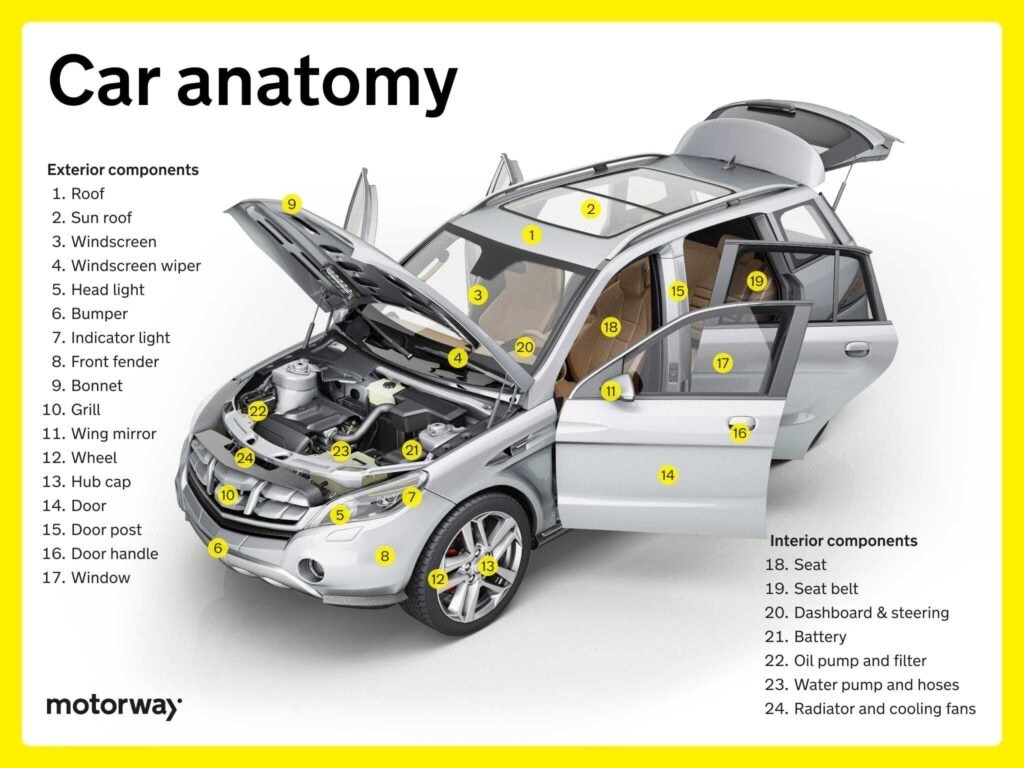
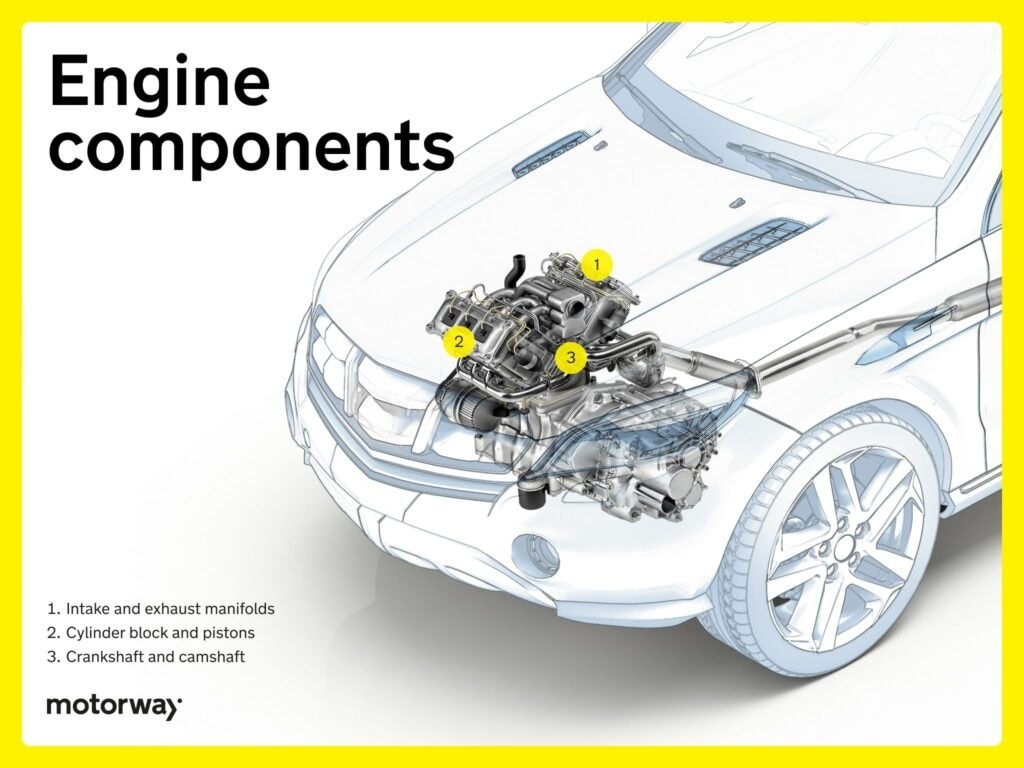
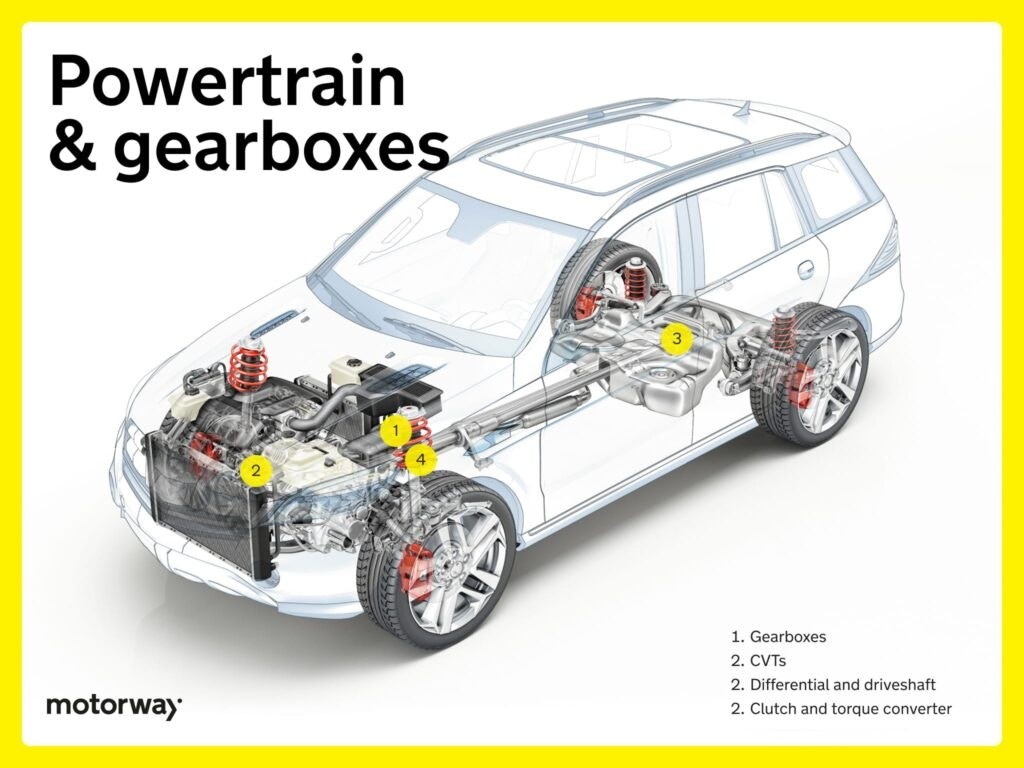
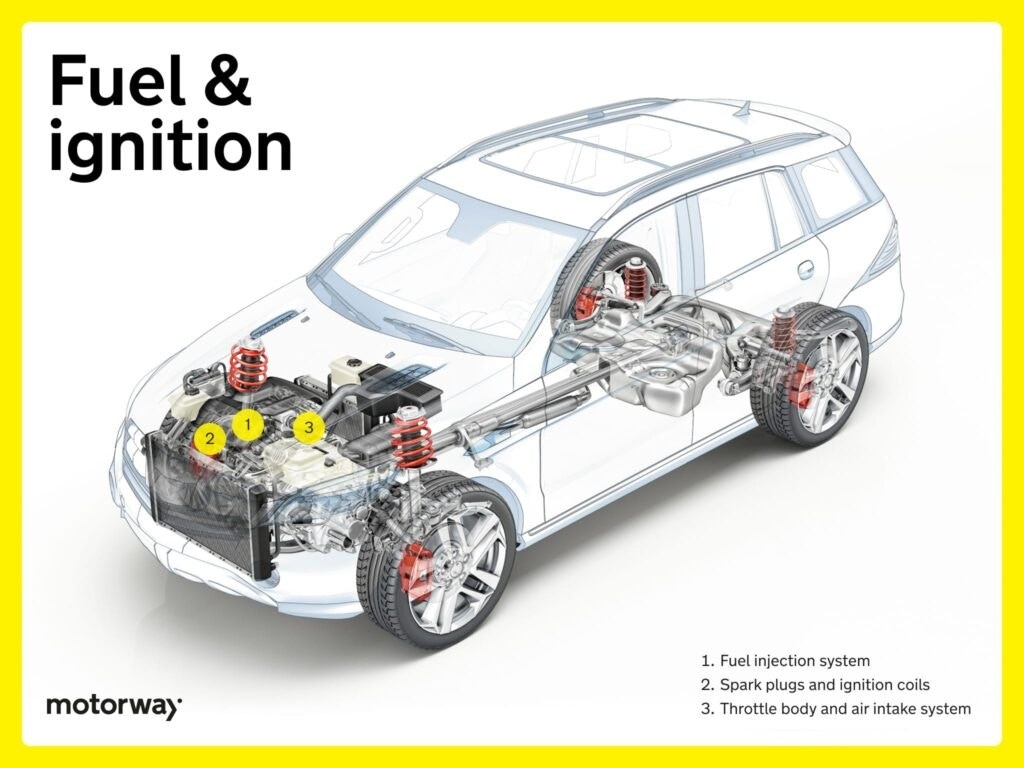
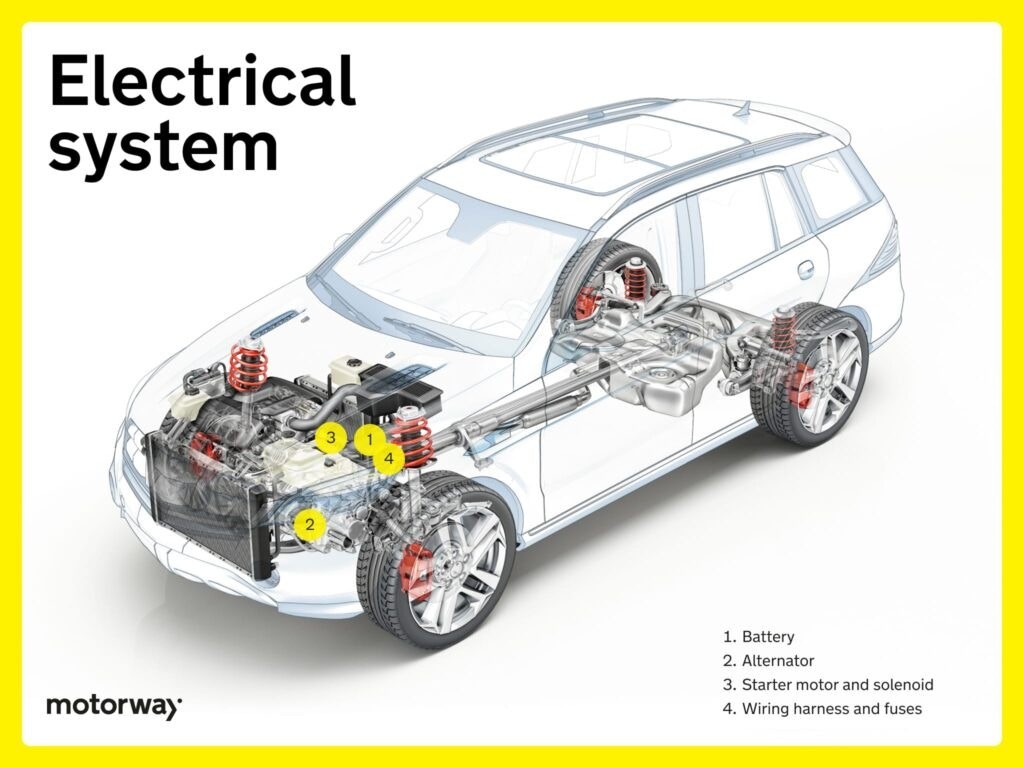
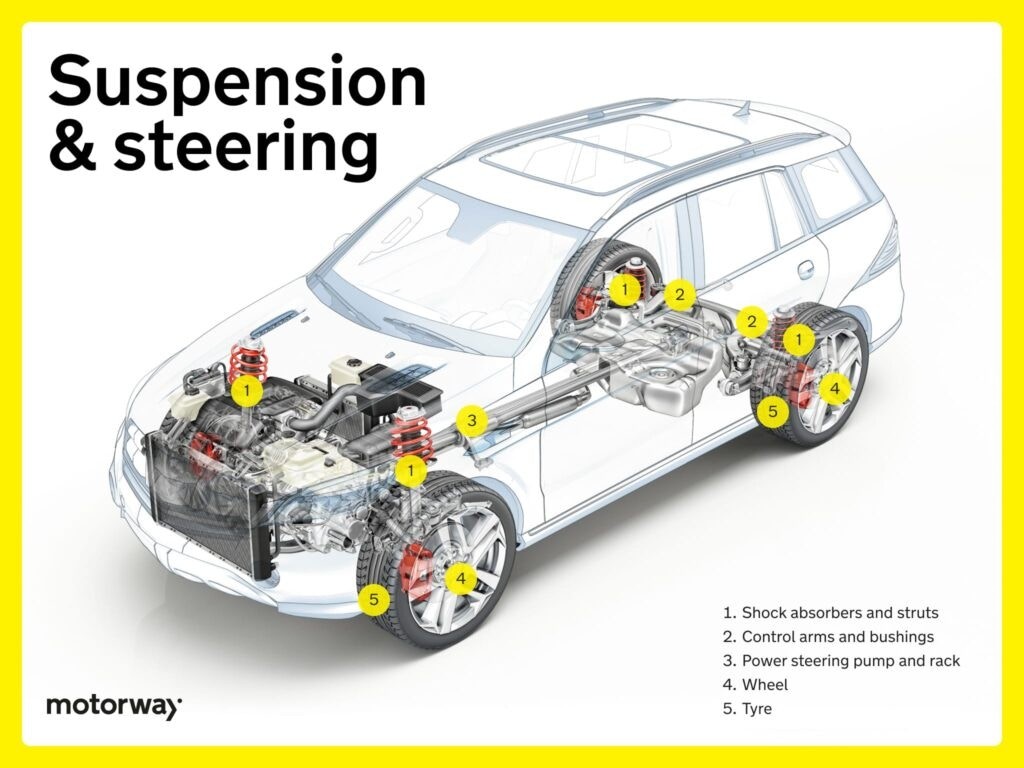
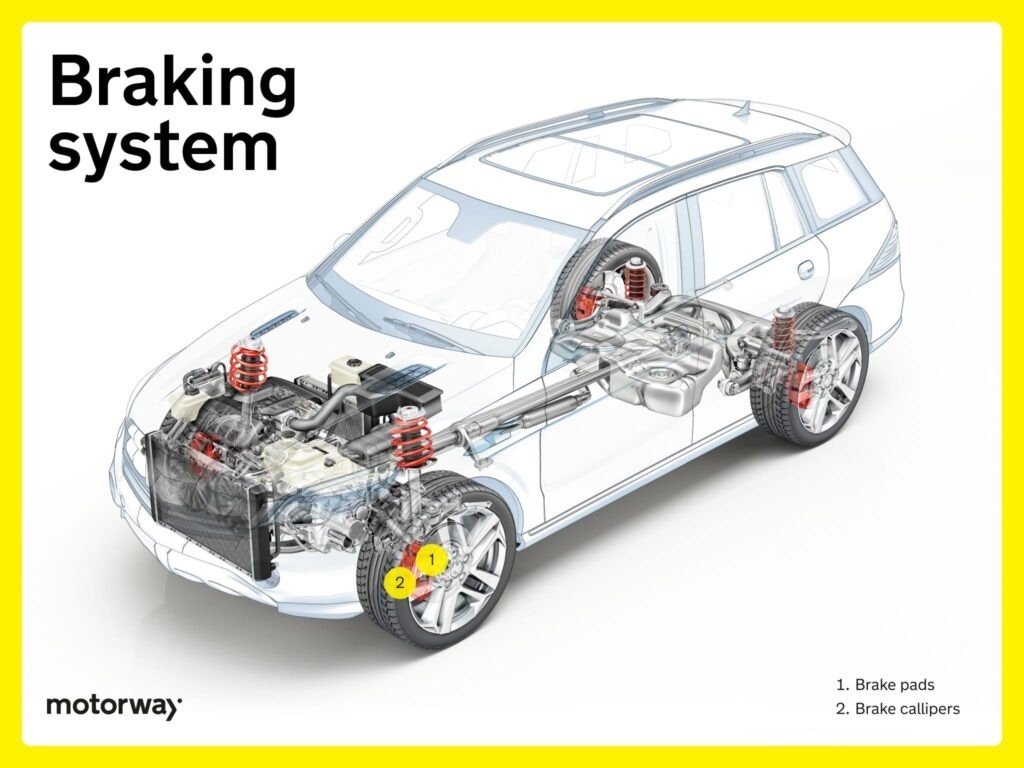
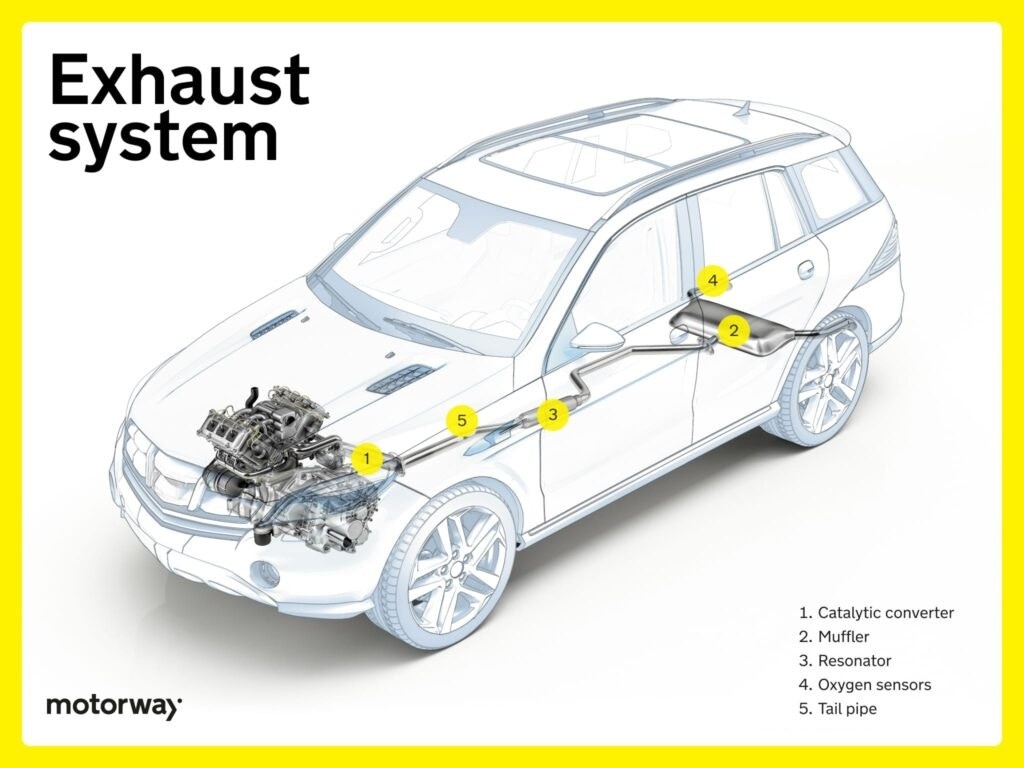
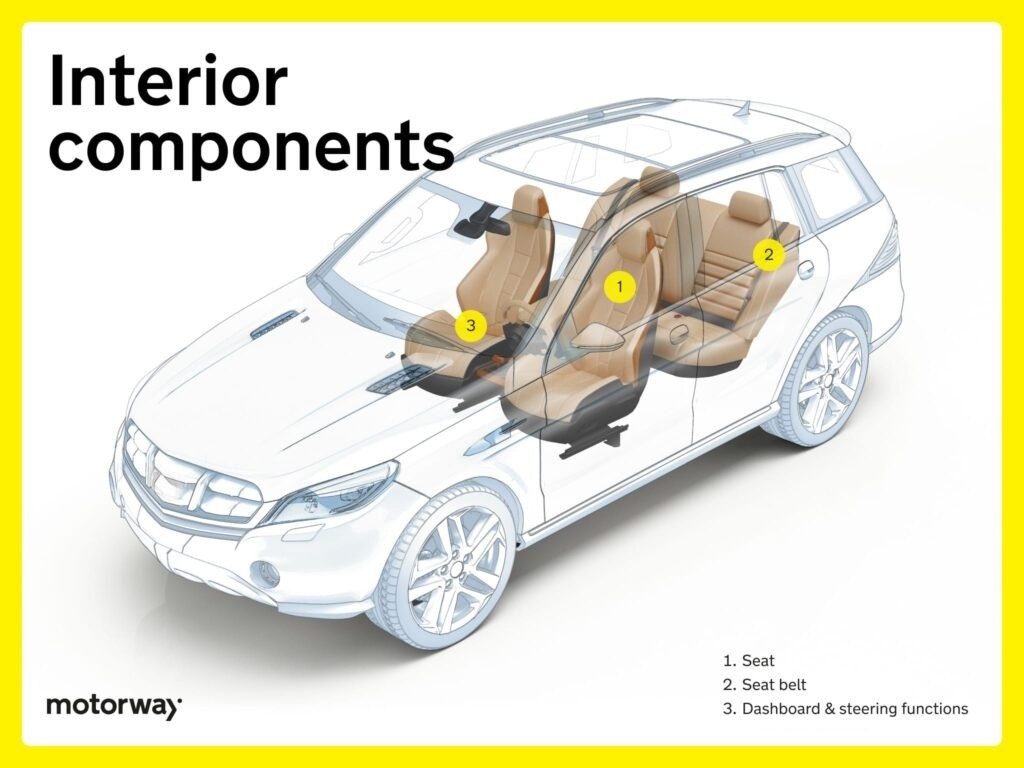
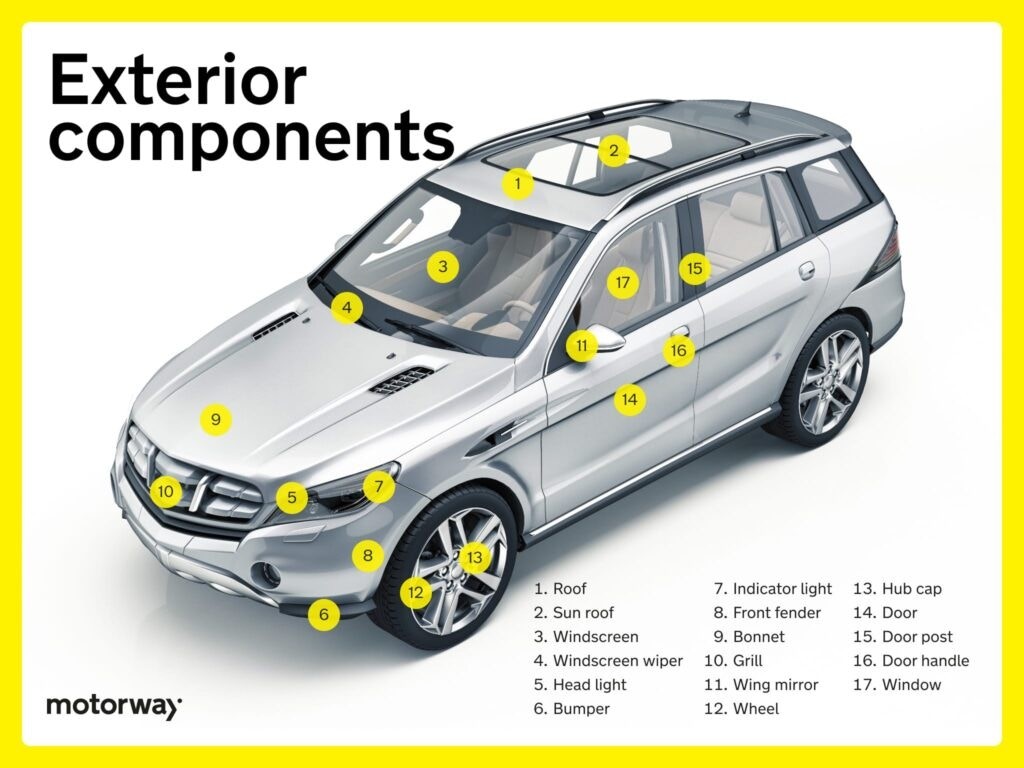
Wheel Construction Guide: Alloy vs. Steel Wheels
Wheel construction varies, impacting weight, strength, and aesthetics.
- One-piece construction: Wheels made from a single piece of material (alloy or steel), common for standard wheels.
- Two-piece construction: Wheels made from two parts (center and rim) joined together, often found in performance wheels.
- Three-piece construction: Wheels with three components (center, outer rim, inner hoop) for customization, popular in aftermarket wheels.
- Forged construction: Wheels made from compressed metal, resulting in stronger and lighter wheels, used in high-performance applications.
- Multi-piece construction: Wheels composed of multiple parts for maximum customization and versatility.
Material choices include:
- Alloy wheels: Made from aluminum or magnesium alloys, lightweight for better handling and heat dissipation, and aesthetically appealing.
- Steel wheels: Constructed from steel, durable and cost-effective, suitable for rugged conditions, though heavier than alloy wheels.
Tyre Pressure Monitoring System (TPMS)
The TPMS is a safety system that monitors tyre pressure in real-time using sensors in each tyre. It alerts the driver if tyre pressure drops below recommended levels.
Maintaining correct tyre pressure improves safety, fuel efficiency, and tyre lifespan, making TPMS a valuable safety and maintenance part of a car.
FAQs
What parts are under a car?
Beneath a car, you’ll find essential systems such as the engine, transmission, suspension, exhaust system, and fuel system. These are all integral parts of a car, working collectively to ensure vehicle operation and performance.
How many car parts are on a car?
The total number of parts in a modern car can exceed 30,000, encompassing everything from mechanical components to electronic systems. Electric vehicles typically have fewer parts due to simpler powertrains, highlighting the complexity of traditional internal combustion engine vehicles when considering all parts of a car.
What are the important parts of a vehicle?
Key vehicle parts include the engine, transmission, braking system, steering system, suspension, and electrical system. Each plays a critical role in vehicle safety, performance, and reliability, representing the most functionally significant parts of a car.
What parts of a car can be sold separately?
Individual car parts like engines, transmissions, body panels, and specific electrical components can be sold separately in the aftermarket. The demand and availability of these parts fluctuate based on vehicle models and repair needs, offering a market for individual parts of a car.
Why is there a shortage of car parts?
Car part shortages can stem from various factors, including supply chain disruptions, increased demand, manufacturing bottlenecks, and global events impacting production and logistics. These factors can collectively lead to scarcity in certain parts of a car, affecting vehicle production and repair times.
Need to sell your car?
Want to learn more about car ownership, maintenance, and selling your car? Explore our guides here for information on everything from Clean Air Zones to car tax and vehicle modifications.